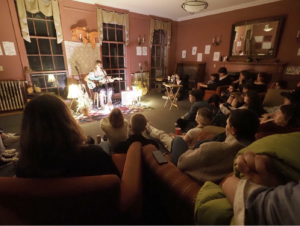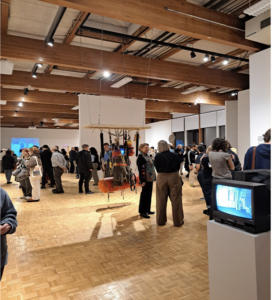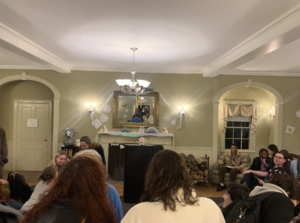Being the “totally super-current gamer” that I am, I only finished Red Dead Redemption 2 a few months ago. I initially got the game in June 2019, a little less than eight months after its release. I played through the first couple of missions but found cleaning guns, real-time travel, and keeping a good reputation tedious so I put it away for a while… that is until mid-January 2021. I don’t exactly know why I picked it back up but I’m glad I did because I had a ton of fun with it. Red Dead Redemption 2 is a prequel to 2010’s Red Dead Redemption. It follows the character of Arthur Morgan, the hardened enforcer of a sizable gang of outlaws. In the midst of gaming, I decided to turn over a new leaf as Arthur Morgan and be a good citizen. One of the first steps to gaining a good reputation is paying your bounty, accrued from illegal actions such as robbery, harming civilians, and initiating violence. My bounties were around $490 in total so I slunk off into the woods with my rifle to pay these down and started tracking down deer, turkeys, rabbits, the occasional wolf, elk, and even a bear or two. Little by little, the profits from the pelts and meat started adding up.
I had paid off my bounty in the territory of New Hanover and was in West Elizabeth, trying to earn enough money to pay off the last bit of my bounty. I was north of the town of Strawberry in the middle of a hunt. Admittedly, I don’t have a particular strategy when I hunt in Red Dead Redemption 2. I usually ride my horse to an area and search around until I find animals to hunt. Since I do not go into any specific area, I tend to end up in a place I have not explored before. I rode my horse up a narrow mountain path, all the way until I spotted an eagle. I aimed my rifle and one clean shot later, I was sprinting over to skin it. On the way down, I stumbled upon a frightening sight.
There was a small concave area on the side of the mountain that housed a haunting scene. I was in disbelief at this sight, it took me a few seconds to comprehend the words, Giant Remains, that appeared in the bottom right of my screen. This huge skeleton, with a dab of brown hair on his head, lay like a silent pinnacle. The skeleton is damaged, with certain bones missing and others intensely weathered, yet protected enough from the elements that its overall structure remains intact. This is one of the games’ many Points of Interest. Points of Interest are oddities in the world that can be examined including a mammoth skeleton, an abandoned church, meditating monk, the site of a Pagan ritual, and many others. While strange and unnerving, it can be believed that one might find something like this in the less explored and more rural areas of the map. Once I had adjusted to this truly eerie sight, I inspected it. Every time Arthur inspects one of these sights, a new journal entry is written down. The Giant Remains journal entry shows a drawing of the skeleton with an entry underneath: “Found a massive skeleton. Wonder how big the man was, or if he was a man at all.”
Red Dead Redemption 2 is not a game with supernatural elements. Yes, there are several ‘UFO’ and ‘Ghost’ easter eggs, but those are clearly self-aware and tongue-in-cheek references. However, with the exception of its predecessor’s Undead Nightmare DLC, which added zombies, sasquatch, chupacabra, and other creatures from folklore into the game, this is a series that tries its best to stay grounded in realism. There was nothing left for me to do on the mountain, so I hopped on my Tennessee Walker and galloped back to Strawberry to sell the pelts.
I found a big skeleton, so what? Well, I think this is more than a spooky scene, it references one of the game’s overall themes: The American Dream. The entire Red Dead franchise is set at the tail end of the Wild West, Red Dead Redemption 2 is specifically set in 1899. The days of settlers journeying to ‘undiscovered’ land are over. Gunslingers dueling in the streets are relics of the past. For lack of better words, the West has been won. With white Americans settling much of the land and expanding Americana, the sense of an untamed frontier has mostly vanished. The character of Arthur Morgan refuses to accept this, since he is, in a way, lost in time. He tries to live in a world that is ceasing to exist, because it is the only world he knows. With the final elements of the Wild West fading, we return to the skeleton. Next to the giant skeleton lies the skull of an ox and a large broken club. I propose that this skeleton belonged to Paul Bunyan.
Paul Bunyan is a North American folk hero representing the pioneer spirit. He was a lumberjack described as being incredibly tall and strong. In many stories, he is accompanied by Babe, his giant blue ox; together they embody Manifest Destiny. Stories tell of him dragging his ax in the ground, creating the Grand Canyon; Mount Hood is the result of him putting stones on his campfire; Bunyan and Babe left footprints all over Minnesota, resulting in the 10,000 lakes. In many ways, the tall tales of Bunyan parallel white Americans settling the West, with the idea that the features of this ‘new’ land could not have just occurred on its own. But this skeleton shows that Bunyan is dead. Not just dead, the skeleton has a large crack in its skull, and not too far from Bunyan’s skeleton, is a decapitated skeleton the size of a regular person. Bunyan and the American Dream of the 19th Century did not die peacefully from natural causes, they died violent and painful deaths.
This version of The American Dream, largely made up of Manifest Destiny, was murdered by the very settlers who believed in it. With the death of this dream, the West is no longer a place for impoverished laborers to build farming communities, industrialization careens towards the region. Even the settlements of Strawberry, Valentine, and Emerald Ranch, all small communities with little industry will soon become vessels for capitalist profit. The American Dream of the 1800s did exactly what it was meant to do––give people a promise, make that promise seem tangible, then crush it the moment businesses could monetize it. This was not just the case in the Wild West. The post-WWII American Dream of the nuclear family living in suburbia gave white Americans comfort, while the evils of racism continued to fester and feast on the heart of civilization. While Johnny gets a Studebaker for his 16th birthday, corporate America is building a vast military-industrial complex, whose thirst for blood can only be temporarily quenched by the death of millions.
The post-Cold War American Dream was exported worldwide. The dream of Liberal Democracy and Neoliberal Capitalism reigning supreme were the peaks of idealism to many young people who had only known authoritarianism. Most former Soviet Republics were democratic at the beginning of the nineties. Many of them fell to kleptocracy, despotism, and corruption not long after the first ballots were cast. Sham elections, drastic decreases in life expectancy, and oligarchy became the norm. Russians today have less freedom than they did during many eras of the Soviet Union. Those young idealists saw the American Dream disappear before it even began. Meanwhile, in America, corporations saw their profits rocketing into the stratosphere as free trade policies like NAFTA were successfully lobbied into law. Union jobs evaporated overnight, entire towns were laid off, all while sweatshops were being opened overseas. Clinton-era policies gutted welfare, criminalized poverty, and created predatory organizations like the WTO. It was not the end of history, it was the recycling of authority.
In the midst of the forever wars, a loaded gun was fired into the heart of the modern American Dream. The goal of going off to college, getting a degree, buying a home, and living a better life than your parents had, came to a screeching halt. The housing market crashed, millions of honest and hardworking Americans were rendered jobless and homeless all because of corporate greed. Instead of getting prison time, the bankers on Wall Street got bailouts. Many of those same banks are now making record profits.
When this skeleton was put into the game, I don’t think the devs at Rockstar Games were making a fun reference to Paul Bunyan, I think they were making a profound statement about the American Dream, both then, and now. Without spoiling the game series, I will say that the broad strokes of these games are grim. The prospects of many Americans, who have woken up from the American Dream, are even grimmer. The game’s commentary says that no matter how many good deeds you do or how much you help those in need, you, as an individual, are disposable in the eyes of those in power. According to the themes of the game, we will all ultimately revert back to our primal instinct of ‘us vs. them’, greed, and mob mentality. It seems to tell the player that things can never get better, that the only way is down, but I beg to differ. I don’t think it’s hopeless. Look at the strides made in LGBTQ+ rights, at the young open leftists who are unseating decades-old established politicians, and movements like BDS that are gaining tangible support. The ongoing Black Lives Matter movement and protests against police brutality are the largest protest movements in American history, and likely, in world history. Red Dead Redemption 2 may just seem like a cowboy game, but it is a piece of art. Not only in terms of its brilliant writing, vast open world, and top-of-the-line mechanics but also because it speaks to the people– their hopes, their dreams, their fears, their anxieties about the future, and their jadedness. Like many great pieces of art, I hope Red Dead Redemption 2 will inspire at least some people to fight for progress.





Be First to Comment